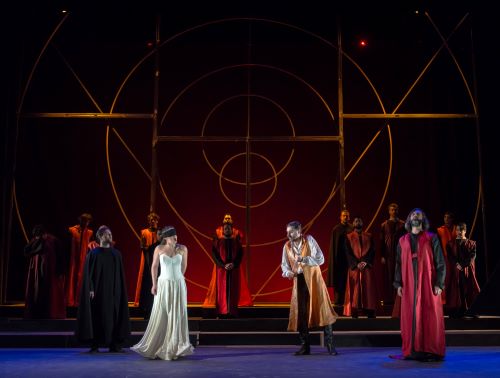 Argentina Mozart, Die Zauberflöte: Soloists, Chorus and Orchestra of Juventus Lyrica / Hernán Schvartzman (conductor), Teatro Avenida, Buenos Aires. 26.7.2019. (JSJ)
Argentina Mozart, Die Zauberflöte: Soloists, Chorus and Orchestra of Juventus Lyrica / Hernán Schvartzman (conductor), Teatro Avenida, Buenos Aires. 26.7.2019. (JSJ)

Production:
Director/costumes – María Jaunarena
Sets/lighting – Gonzalo Córdova
Chorus – Hernán Sánchez Arteaga
Cast:
Tamino – Nazareth Aufe
Pamina – Jaquelina Livieri
Papageno – Gabriel Carasso
Papagena – Ana Sampedro
Queen of the Night – Oriana Favaro
Sarastro – Walter Schwartz
Three ladies – Laura Penchi, Verónica Canaves, Rocío Arbizu
Monóstatos – Patricio Oliveira
Speaker – Felipe Cudiña Begovic
Juventus Lyrica has continued its 20th anniversary year with a revival of its 2013 production of Mozart’s Magic Flute – quite appropriately as the work was one of its early productions all those years ago.
At the time, I labelled the production a ‘somewhat Magical Flute’ with the tendency for over-acting by the Papageno/Papagena pair. Cue Gabriel Carasso once again appearing as Papageno and a ‘new’ Papagena in Ana Sampedro and that has to a large extent been toned down, with the former also appearing less the simpleton than previously, making for an altogether more satisfying and ‘magical’ production.
That is of course not to understate the equally important roles of the rest of the cast in contributing to the whole. Uruguayan tenor Nazareth Aufe was a solid Tamino, warming to the role during the performance, and Jaquelina Livieri a powerful Pamina.
Oriana Favaro well handled the demands of the Queen of the Night, despite an unexpected health setback in the first act, and the three ladies – Laura Penchi, Verónica Canaves and Rocío Arbizu – brought an up-front approach to their collective role.
Walter Schwartz was sufficiently commanding as Sarastro, although lacking power in his lower notes, and Patricio Oliveira repeated his comedically coarse Monostatos.
María Jaunarena’s production is founded on simplicity and suggestion, as exemplified in the sets and lighting from Gonzalo Córdova. Thus, the geometric figures are suggestive of ‘higher things’ and the Queen of the Night appears from a moon-like doorway, while for example the ‘tests’ are conducted with flames and water represented by light and without any special effects. Similarly, in the costumes with for example the Queen of the Night and the three ladies in black bat-like dresses.
The musical direction was again in the hands of long-time collaborator Hernán Schvartzman, who once again presented a polished performance. Likewise, the chorus trained by Hernán Sánchez Arteaga was well prepared for its various interventions.
Jonathan Spencer Jones
